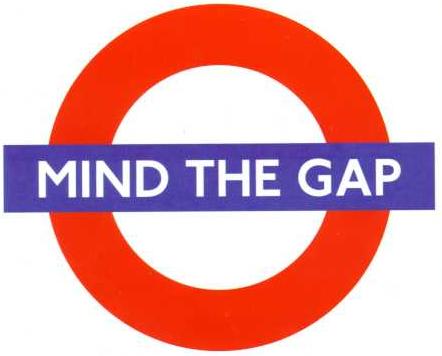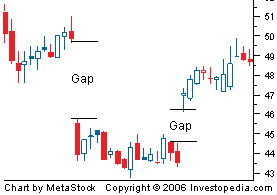
Price Action Gap Trading Strategies
- Home / Non Member Articles (Free) / Price Action Gap Trading Strategies


One of the things that we consider at the open each morning whenever trading the ES, or any market for that matter, is where prices opened during regular market hours in relation to the previous days close of the regular market. Was there a gap higher or a gap lower at the regular open and if so, how does price action trading relate to that gap and price action gap trading strategies? First, let’s discuss exactly what a gap is and then we will explain why we have a price action trading strategy for gaps on the chart.

Normally in any market with sufficient volume, you will not see a gap in the price action or on the printed chart. What you will notice is that as each bar forms or prints to a chart, that the bars almost always have overlap between them. It’s when one bar closes and the next bar opens and there is no overlap in the prices that you will see a gap. Below is a definition of gaps that we found at www.investopedia.com.
A break between prices on a chart that occurs when the price of a stock makes a sharp move up or down with no trading occurring in between. Gaps can be created by factors such as regular buying or selling pressure, earnings announcements, a change in an analyst’s outlook or any other type of news release.

An example of two different gaps can be seen in the chart above. Notice how the stock closes the trading session before the first gap at $50 and opens the next trading day near $46 with no trading occurring between the two prices. Gaps are a regular occurrence in all financial markets. However, they are rarely seen in the forex market since it is highly liquid and trades 24 hours a day.
Notice that they actually discuss multiple variations of gap types as well, and while we are not as interested in identifying the type of gap, it doesn’t hurt to brush up on gaps and learn as much as you can. The bottom line in regards to gaps as far as price action trading is concerned is simply being able to recognize a gap and then attempting to act accordingly if necessary to take advantage of any opportunity the gap gives you in trading that day. The overall idea is to not get suckered or tricked into the frenzy that occurs at the market open when there are gaps, but rather to give the price action time to settle down and see if prices will reverse and attempt to fill the gap. In most cases, this will happen, but you must be certain to follow the price action, because prices will not fill the gap on the same day 100% of the time.
Just understand that in the majority of cases, the rule is that prices will attempt to reverse and fill any opening gaps, even if it takes some time for the reversal or turn back to fill the gap some time to build steam. Our stance on trading gaps is that we never want to trade them blindly or simply assume that they will be filled. We prefer to get confirmation from the price action, and for this reason, you must understand price action trading, while also understanding how to read a price chart. You are probably asking yourself why prices tend to fill these gaps, and below is an excerpt from another article that we found that attempts to answer this question. Below is what the article at www.contrarianlifestyle.com had to say about why gaps are filled.
A common maxim in technical analysis is that a stock will always fill the gap. However, looking at this issue empirically, at what rate do gaps actually fill? Also why would this pattern continue to persist. The reason that gaps tend to fill is investor psychology of liking to see the price of a stock to be continuous and opportunistic short sellers to profit off of retail investors sudden jump into the stock.
The general public will often get excited about a particular aspect of a stock such as a positive earnings report published after hours, a bullish change in a daily technical indicator, economic news that will help the security, an election, or any other piece of other sentiment driving news. As a result, they will buy the given security after hours so that the opening price the next trade is significantly higher than the previous close. Short sellers see this as an opportunity and the price will creep down a little bit. The same investors who bought into the gap creating hype will panic on the slight downturn and add to selling pressure. As a result, the gap will fill before professional investors either cover their shorts or buy back after the news hype goes away. Other possible factors that may drive gap fills include the self fulfilling nature of technical analysis or irrational exuberance.
How can investors profit from the filling of these gaps is by either shorting these stocks directly or via options with put spreads (buy put at current price, sell at pre gap price). Using equity or options is depend on an individual investors risk capacity and familiarity with each type of security, but both will allow you to profit off the trade.
While this article talks about stocks, these rules hold true for any market that has sufficient trading volume. There are some thinly traded markets where there is low volume, and you will often see many gaps on these charts, so don’t attempt to even trade those markets at all, because not only will the gap theories not hold true, any attempt to use price action gap trading strategies is probably futile.
As long as you understand price action and follow our price action strategies when trading gaps, you should not have an issue with getting fooled, because there will be price action patterns that will point you in the right direction, giving you clues as to when the price action gap is losing steam and when prices are actually trending or working back to fill the gap. By simply being aware of the gap and knowing the bias, you can then get clarification or confirmation by watching the price action, thus improving the odds of you getting the direction of prices correct. No matter why you are trading, whether it be gaps or some other bias, you will be at a distinct disadvantage if you can not read a price chart. If you want to learn to trade with price action and read a chart like a pro, then you will want to visit http://priceactiontradingsystem.com/pats-price-action-trading-manual/.
This site uses Akismet to reduce spam. Learn how your comment data is processed.
Comments
leanghor October 3, 2012 at
I comment all the friends and find the friends